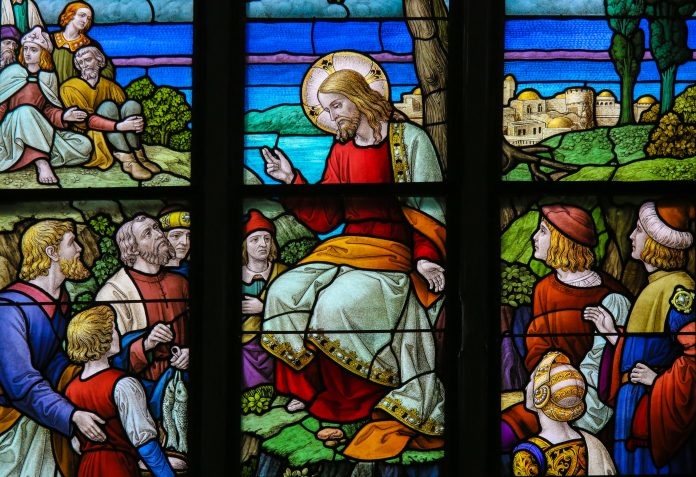
by Angela Ann Zukowski, MHSH, D.Min.
See the end of this article for an Expanded Study Guide and Additional Reading.
This is the last article in the series titled “The Mystery and Wonder of the Parables.” Throughout the last six articles, we have been invited to capture anew the meaning, richness, and beauty of Jesus’ parables. We have discovered that the parables are more than simple, short stories that entertain us. Rather, parables are bold challenges that rekindle our understanding of the Kingdom of God and the meaning of discipleship.
There is a strong moral imperative streaming through the parables. While the cultural context of the Gospel parables differs from our own, the meaning and importance of their implications are timeless.
A Culture of Distraction
Today we live in a culture of distraction. There are many facets within contemporary culture that pull us in many directions.
These distractions demand much of us with or without our conscious recognition. They are a kind of magnetic force that seemingly distracts us from our primary objective in life. In fact, we can become so disoriented that the disorientation may seem normal, seamless, and authentic as opposed to a diminishment of who we are called to be and become. We may experience a kind of scotoma that prevents us from seeing authentic goodness, beauty, and truth. As a result, we need something to remove the scotoma so that we can realign our lives in view of the Kingdom of God.
Imagine what it would be like if each of us lived as if God’s kingdom were right around the corner. Yes, this takes imagination!
Jesus’ parables were a great technique to capture the religious imagination of his hearers to prepare them to receive his message. He would set up a scenario only to take the ending in a completely different direction from what his listeners expected. He would turn the tables on his audience and leave them surprised, wondering, angry, perplexed, or enlightened. His parables always had impact!
Catechists and the Religious Imagination
What can we, as catechists, learn about the religious imagination that can enable us to communicate the Good News in an effective way? G.K. Chesterton asserted that there is much more to Christian faith than intellectual assent and moral conformity to the creeds and doctrines: “Faith, in fact, embraces imagination.” To leave the imagination out of the picture of the human being is to settle for an incomplete and therefore inaccurate picture. As a fountainhead of imagination himself, Chesterton personified his belief that Christian faith includes our God-given capacity to wonder, imagine, and create.
Sallie McFague wrote: “Where theology becomes overly abstract, conceptual, and systematic, it separates thought and life, belief and practice, words and their embodiment, making it more difficult, if not impossible, for us to believe in our hearts what we confess with our lips” (Speaking in Parables: A Study in Metaphor and Theology, Fortress Press, 1975).
Jesus’ use of parables was not abstract, conceptual, or systematic. Rather, his parables were a means for communicating a sense of the Great Mystery, the inexpressible that embraced and surrounded his audience. If his listeners “had ears to hear and understand,” they could begin to re-imagine possibilities to alter their own lives in light of the Kingdom of God.
Author and educator Catherine Cory frequently speaks to the fact that the religious imagination enables us to contemplate the Scriptures and step through the images, as through a window, to encounter the reality it represents and be so changed in our being and doing in this present world—so much so that the imagined world of the Scriptures becomes real. It is what we profess when we talk about the “already and not yet” Kingdom of God (“Imagine That! Apocalyptic Literature and Religious Imagination.” The Bible Today. July/August 2011).
As catechists, we have to awaken within ourselves a renewed capacity to wonder, imagine, and create if we are to stir the faith embers of our students’ lives to be aflame with love for God and neighbor. Not simply embers but flames!
And so we do well to consider seriously the value of going back to the first ways that God spoke through his prophets (in sign, symbol, metaphor, and anecdote) and his Son (in parables). To that extent, we begin to grasp the essence for a catechesis of storytelling (biblical storytelling). This skill needs to be intensified within Catholic Church ministries! It requires us to go back to the original language to hear the message not as a book but as poetry and story and all the other literary forms used to express the inexpressible.
As catechists, perhaps we ought to practice becoming great storytellers of the Kingdom of God! I mean great! Really great! This means intentional study and practice! Practice, practice, and practice!
Communicating Faith in a Digital Civilization
The twenty-first-century digital civilization presents catechists with enormous challenges never before experienced! In his apostolic letter titled Porta fidei (“Door of Faith”), Pope Benedict XVI called us “to arouse in every believer the aspiration to profess the faith in fullness, and with renewed conviction, with confidence and hope” (n. 9). This endeavor requires more than books, lectures, and activities that may lack opportunities for critical reflection, relevant contemplation, and integration of the meaning and significant place of the Kingdom of God in our lives. Rather, we need to stir the embers of our own faith life and discover new methodologies for communicating with the rapidly evolving digitally oriented brains of our students.
Already there is a vast ocean of research and dialogue addressing how thinking, learning, and processing information are altering functions within the brain. These changes are the results of the rapid evolution of digital resources and the significant amount of time our students are spending with these resources. As catechists, we can no longer ignore this fact. We must assertively engage in the study and application of the digital evolution if there is to be a difference in the outcome of our catechetical efforts.
The “Pastoral Instruction on Social Communications” (Aetatis novae, n. 11, 1992) quotes from Redemptoris missio (“Mission of the Redeemer,” 1990), pointing out that we are living in a time of a “new culture created by modern communications…with new languages, new techniques, and a new psychology.” This is our new reality. Thus, our techniques must change if we are to reach our students and inspire them to nurture a deep and meaningful friendship with Jesus (more than a Facebook “friend”) and be authentic witnesses—disciples in a changing world. This must be a radically new and conscious effort on our part if we are to make a difference.
Twentieth-century methodologies simply no longer work! Yet, many continue to catechize even with nineteenth-century methodologies—and we wonder why our students are not interested in what we strive to teach and proclaim.
Look Around!
Jesus’ message was counter-cultural. It contrasted deeply with the dominant culture. So today, how do you capture the religious imaginations of your students who are absorbed in today’s dominant digital culture? Look around! What do you see happening around you or in the lives of your students? To what and to whom are your students listening? What or who is dominating their attentions and imaginations? Where are they spending their time and energy? What are the dominant cultural stories they are hearing, and where are they hearing these stories? How does the dominant culture influence the perceptions they have of themselves and their desired ultimate life goals? How do we use these digital tools for effective catechesis?
Theologian and author Fr. James Bacik, reflecting about finding God in ordinary experiences, believes that our imagination has an explicitly religious function. He speaks of Fr. Andrew Greeley’s book titled The Religious Imagination (Sadlier, 1981), pointing out that our imaginations are shaped by the residue of pictures and images that are stored up as a result of our personal experiences and encounters with the symbols and stories of our religious tradition. Father Greeley’s research suggests that Catholics who have warm and positive images of God, Christ, Mary, and the afterlife are more likely to experience happy family lives, participate in the life of the Church, and work on behalf of social justice. This reminds us of not only the centrality of our imagination but also of the importance of using our imagination to form positive religious experiences for our students. This latter sentence is critical for catechetical reflection, discernment, and action. Where this is lacking in our students’ lives, the catechetical experience is ever more challenging because it lacks the grounding upon which we can nurture their spiritual lives.
Our Task: Prophetic Ministry
Renowned scholar and biblical interpreter Walter Brueggemann wrote a brief book titled The Prophetic Imagination (Fortress Press, Second Edition, 2001). This may be one of the best little books for catechists to read, reflect on, and pray with in order to understand the task of prophetic ministry in the twenty-first century. Brueggemann offers a direct link with all that has been shared throughout this series on the parables. He states that prophetic ministry consists of offering an alternative perception of reality and letting people see their own history in the light of God’s freedom and his will for justice.
Have you thought of yourself as engaging in a prophetic ministry? Think about it for a moment! Brueggemann posits four points for grasping a sense of prophetic ministry:
*Prophetic ministry evokes an alternative community that knows it is about different things in different ways.
*Prophetic ministry is not some special thing done two days a week. Rather, it is done in, with, and under the acts of diverse ministries. It concerns a stance and a posture or hermeneutic about the world of death and the word of life that can be brought to light in every context.
*Prophetic ministry seeks to penetrate the numbness to face the body of death in which we are caught. The public sharing of pain is one way to let the reality sink in and let the death go.
*Prophetic ministry seeks to penetrate despair so that we can embrace and believe in new futures. There is a yearning for energy in a world grown weary.
Thus, according to Brueggemann, the task of prophetic ministry is to nurture, nourish, and evoke an alternative consciousness and perception to the prevailing consciousness and perception of the dominant culture around us. Is this not what Jesus did as he spoke parables and moved from village to village striving to awaken his hearers to the presence of the Kingdom of God? Now—this is our task! This is your task! This is my task!
The focus on the poorest, the weakest, and the least important has dominated Pope Francis’s public outings since his inaugural Mass on March 19, 2013. Almost on a weekly basis, Pope Francis urges us to leave our comfort zones and reach out to those who live at the margins of society. He applies many images, stories, metaphors, and gestures to capture and link our religious imaginations to his primary message. Once again we see the connection throughout the Church’s history with how Jesus used parables and, now, in how our pope awakens the dominant culture to an alternative consciousness and way of life! Can we, as catechists, do anything less?
Sister Angela Ann Zukowski, MHSH, DMin, is the Director of the Institute for Pastoral Initiatives and a professor in the Department of Religious Studies at the University of Dayton. She is a national and international speaker and consultant for adult faith formation and digital ministry resources.
Expanded Study Guide and Additional Reading
This is the last article in the 2013-2014 University of Dayton Catechist Formation Series titled “The Mystery and Wonder of the Parables.” Sister Angela Ann Zukowski explores how parables connect with our personal and professional lives. What difference do they make in the way we embrace discipleship in the twenty-first century? Religious imagination is part of the essence of parables and quality storytelling. Sister introduces readers to ideas for enhancing their understanding of the religious imagination as essential for effective catechesis. She invites us to explore the skills we need in this evolving digital and multimedia civilization to help prepare our students to encounter and follow Jesus
Reflection Questions
1. Do I believe I live in a culture of distraction? What does this culture of distraction demand of me? How does it influence the way I want to live my life? (Explain.)
2. What is the meaning of scotoma? Do I, my children, my family, or my students experience scotoma? (Explain.)
3. What are some of the significant ideas I recall from previous articles in this series that enriched my understanding and appreciation of the parables?
4. Do I agree with G.K. Chesterton’s comment about the relationship of faith and imagination? (Explain.)
5. What do I think/feel about Sallie McFague’s observation concerning faith? How does her comment relate to this series?
6. How do I attempt to awaken a sense of wonder, imagination, curiosity, and creativity regarding my faith life? (Be specific.)
7. How do I strive to address Porta fidei’s challenge? What challenges are there for me? How do I overcome them?
8. What surprised me about Sister’s reference to the evolution of brain research and its implications for teaching and learning today?
9. What are the methodologies I apply in my catechetical learning environments? Are they nineteenth-century, twentieth-century, or twenty-first-century styles? What must I do to re-think my methodologies?
10. What ideas are sparked when I read the references to Fr. Andrew Greeley’s ideas on religious imagination? Do I see a challenge here in my own catechetical encounters?
11. What is “prophetic ministry”? Do I see my role as a catechist as being prophetic? (Explain.)
Exercises
1. Discuss with your students the meaning of “a culture of distraction” using the following prompt questions: What percentage of your day is spent on the internet or using one or more digital tools/resources? What impact does this have on the time you spend with you family and in academic study?
2. A parable is a metaphor expanded into a story. A story is a sequence of linked events with a beginning, middle, and end. Most parables (scriptural or contemporary) are brief stories. Have students practice writing parables. End each class with reading, reflecting on, and praying with their parables.
3. Have students monitor and journal for one day, hour by hour, how they spend their time. Prepare a series of questions to help them reflect on their use of time. What might they be learning and missing in life?
4. Explore with your students the importance of the imagination. Create an experience whereby the students can create an image of themselves—who they are or who they desire to be—with simple basic resources/tools. Discuss their creative designs. Incorporate their designs into a meaningful prayer service.
5. Discuss with students how they use their imaginations throughout the day. What is the result of using their imaginations throughout the day? What do they learn from “Imagineering”?
6. Invite students to prepare a panel discussion on the meaning and value of the religious imagination for supporting their personal faith life. (This could be videotaped and presented on the parish website.)
7. Invite students to visit the Vatican website and several YouTube clips to prepare a presentation on the style and method of Pope Francis for stimulating the religious imagination of his audiences. Have students describe the impact that Pope Francis has on his audiences.
Additional Reading
Bacik, James J. The Gracious Mystery: Finding God in Ordinary Experience. Cincinnati: St. Anthony Messenger Press, 1987
Bausch, William J. Storytelling: Imagination and Faith. Mystic, CT: Twenty-Third Publications, 1984
Brueggemann, Walter. The Prophetic Imagination. Minneapolis, MN: Fortress Press, 1978
Cory, Catherine. “Imagine That! Apocalyptic Literature and Religious Imagination.” The Bible Today, vol. 49, n. 4 (July/August 2011)
Crossan, John Dominic. The Power of Parable: How Fiction by Jesus Became Fiction about Jesus. New York: HarperCollins Publishers, 201
Greene, Maxine. Releasing the Imagination: Essays on Education, the Arts, and Social Change. San Francisco: Jossey-Bass Publishers, 1995
Copyright 2014, Bayard, Inc. All rights reserved. This article is protected by United States copyright and other intellectual property laws and may not be reproduced, rewritten, distributed, redisseminated, transmitted, displayed, published or broadcast, directly or indirectly, in any medium without the prior written permission of Bayard, Inc.
This article was written by the Catechist Staff and appeared in Catechist magazine, August 2014.
Image Credit: Shutter Stock 510120409




